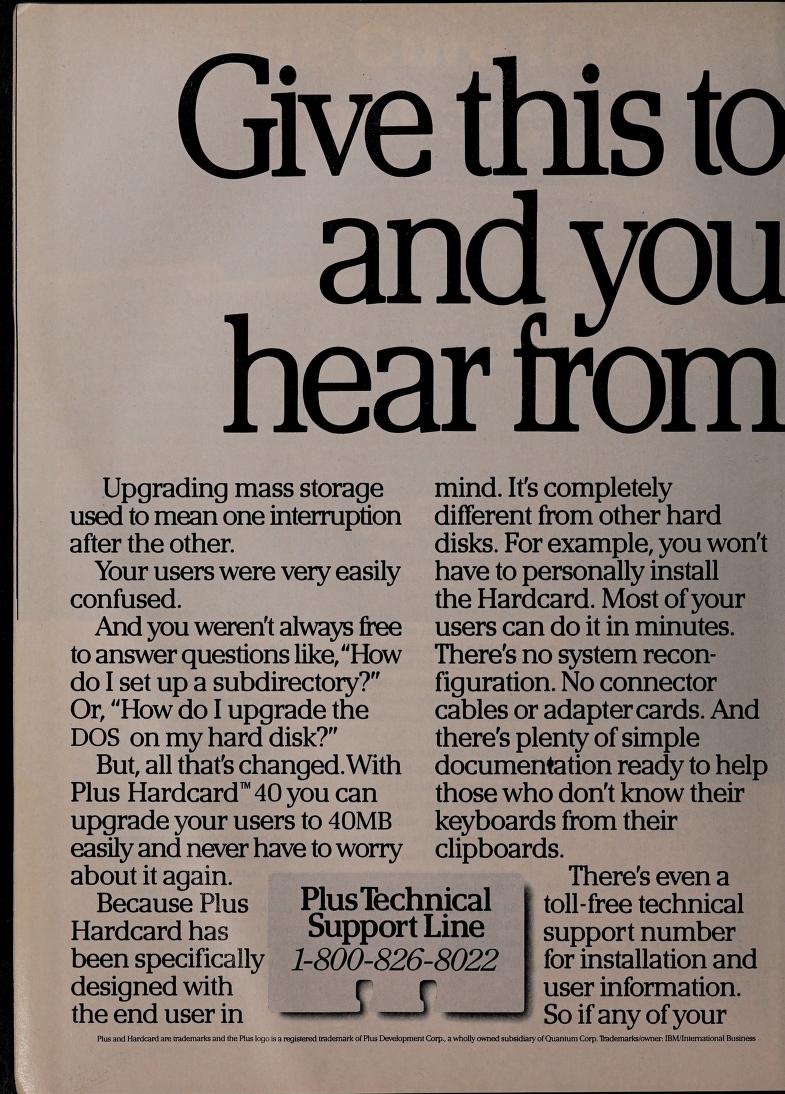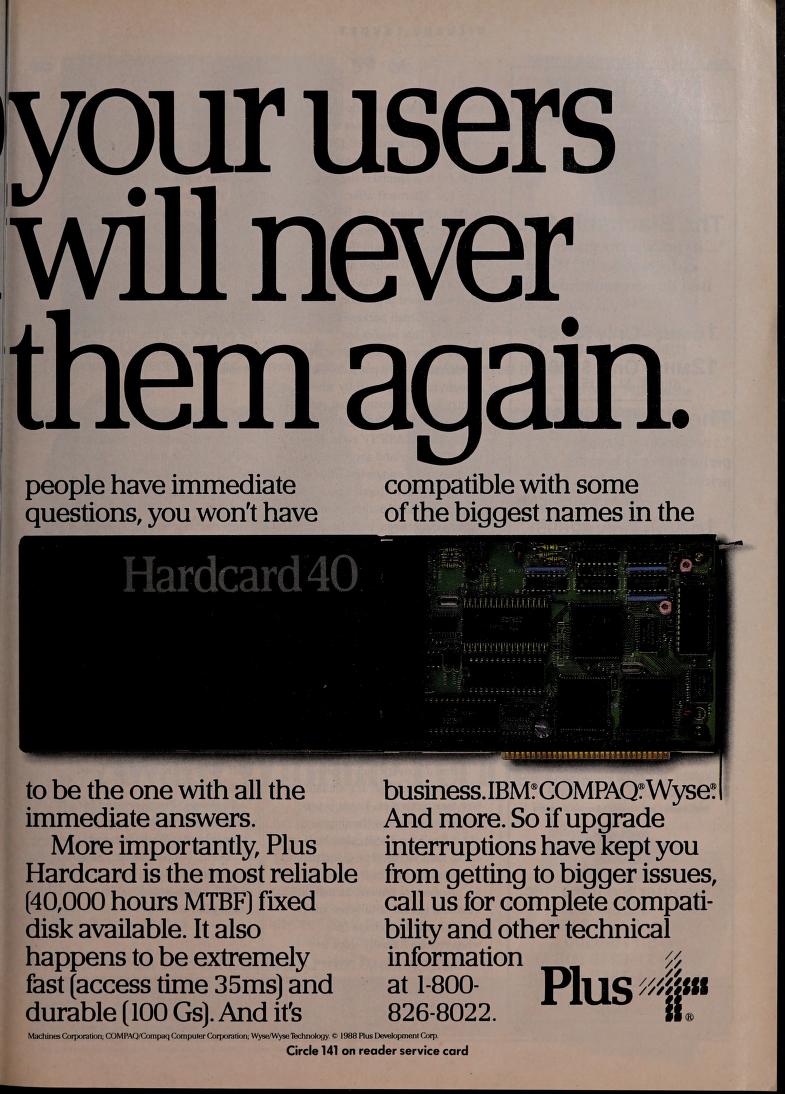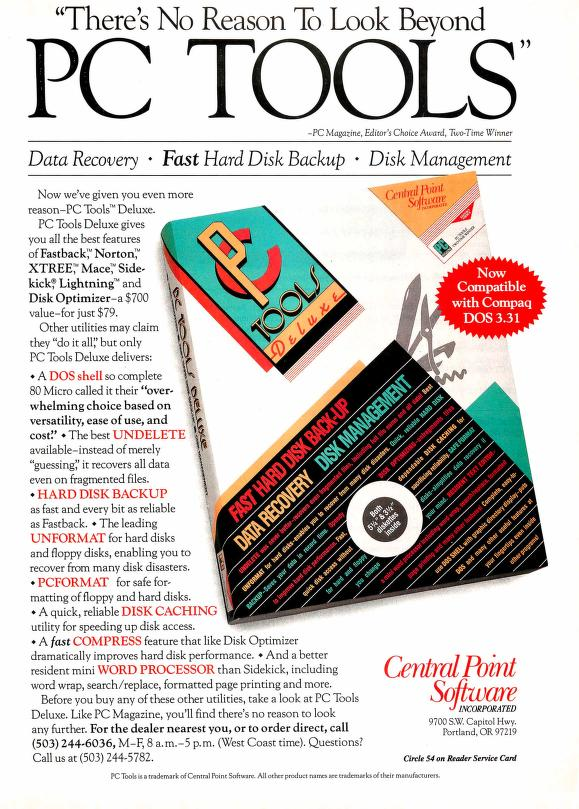 Typical PCs Each Year
Typical PCs Each Year
This year the very first permanent USA-to-Europe internet link was created, called Nordunet as well as Internet Relay Chat (IRC). We had the Winter Olympics in Calgary, AL, where Eddie "The Eagle" Edwards got the longest ski jump in British history. The Soviet Union began its gradual dissolution through growing unrest amongst the republics, starting with the Baltics who were expressing the need for independence, and rebellion in the Caucasus. In our skies, the secretive F117 Nighthawk stealth bomber was officially acknowledged to exist by the US Air Force, and the year ended with the Lockerbie air crash.
For movie-watchers, 1988 brought us a deluge of soon-to-be classics: Rainman, Who Framed Roger Rabbit, Coming to America, Die Hard, Twins, A Fish Called Wanda, and Big. In music, George Michael sung Faith, Guns n Roses came out with Sweet Child O' Mine, Belinda Carlisle topped the charts with Heaven is a Place on Earth and Def Leppard gave us Pour Some Sugar on Me, to name but a fraction of them.
In the world of computing, Steve Jobs unveils the NeXT which came with a Magneto-Optical drive and 3 CPUs, Creative launch the iconic Sound Blaster, the very first computer virus, the Internet Worm, propogated itself across our networks, and Acorn Computers release their new operating system, RISC OS.
Models
A budget model looked something like this:
- Unbranded Intel 8088 @ 10 MHz
- 640 KB RAM
- One or two 5.25" 360 KB floppy drives
- Hercules mono graphics card and monochrome 12" monitor
A mid-range model looked something like this:
- 80286 @ 12 MHz
- 1 MB RAM
- 3.5" 720 KB floppy drive
- 40 MB hard disk
A premium PC looked like this:
- 80386DX @ 16 or 20 MHz
- 1 MB RAM
- 3.5" 1.44 MB floppy drive
- 80 MB - 120 MB hard disk
Laptops
This year we saw much more 80286-based and even 80386-based laptop computers hit the market. Luggables like the Compaq Portable 386 were still popular for customers who wanted expansion capability, as it had standard ISA slots. The GRiDCase 1530 was an 80386-based laptop the same size as a Toshiba T3100 that ran at 12.5 MHz. The fastest clock speed is the Compaq which has a 20 MHz 80386 CPU. NEC V20 and V30-powered laptops are commonplace.
Memory was no longer limited to 640 KB. Higher-spec laptops could support up to 8 MB (GrIDCase 1530) or even 10 MB (Compaq).
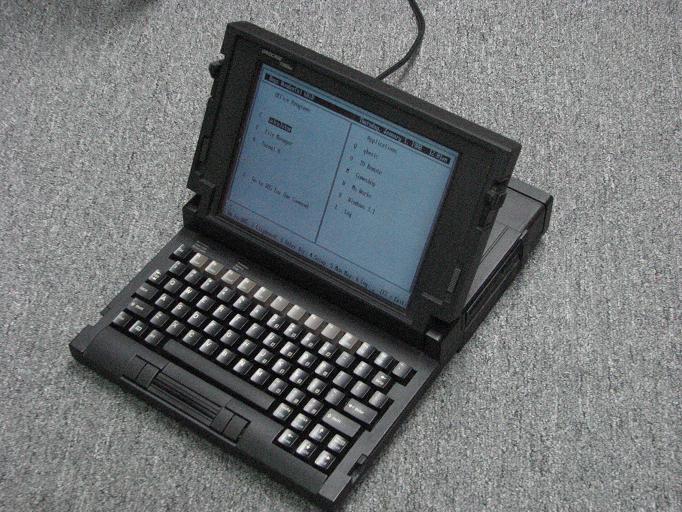
The GrIDCase 1550f
Whilst some machines still had non-backlit LCD displays on their budget offerings (Toshiba's T1000 for example), these became few and far between in 1988, with backlit supertwist (STN) technology the common option - these were brighter and clearer. Nearly all laptops still only supported CGA, but a few early adopters of the new EGA technology could be bought, including the Kaypro 2000 Plus (the first ever to support EGA), and DataVue's Smoke 386.
At the high end of the laptop/luggable/portable PC market were those with a Gas Plasma display. Compaq, GRiD Systems and Toshiba all provided one or more of their computers with this technology. The downside (apart from higher price tag)? Power consumption. Many portables that used Gas Plasma technology only supported an AC mains option for power.
Way down on the budget end of the laptop market, 1988 saw Amstrad launch their new 8086-based laptops. The PPC640 was launched for the small sum of just $999 and came with a built-in 2400 baud modem. It had a supertwist LCD display and single 3.5" floppy disk drive. A second floppy drive could be bought for a further $100.
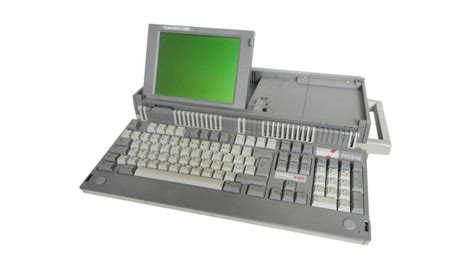
Amstrad PPC640 (1988)
Meanwhile, Toshiba launched two high-end models to the range in the form of the T3200 and T5100. The T3200, priced at $5,499, was built around the 12 MHz 80286 processor and came as standard with a 40 MB hard disk. Like its forebear, the T3100, the T3200 was the same in that it came with two internal expansion slots - one full-length 16-bit one, and a half-length 8-bit one. Meanwhile the T5100 which came with a price tag of $6,499, got a 16 MHz 80386 CPU and 2MB RAM, and also came as standard with a 40 MB hard disk as well as the same gas plasma screen of the T3200.
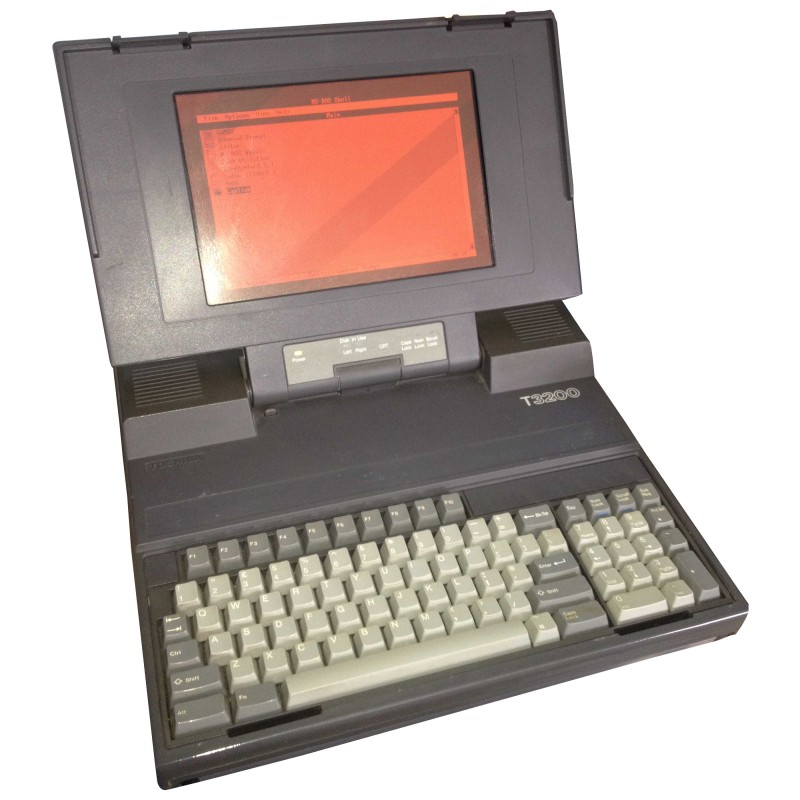
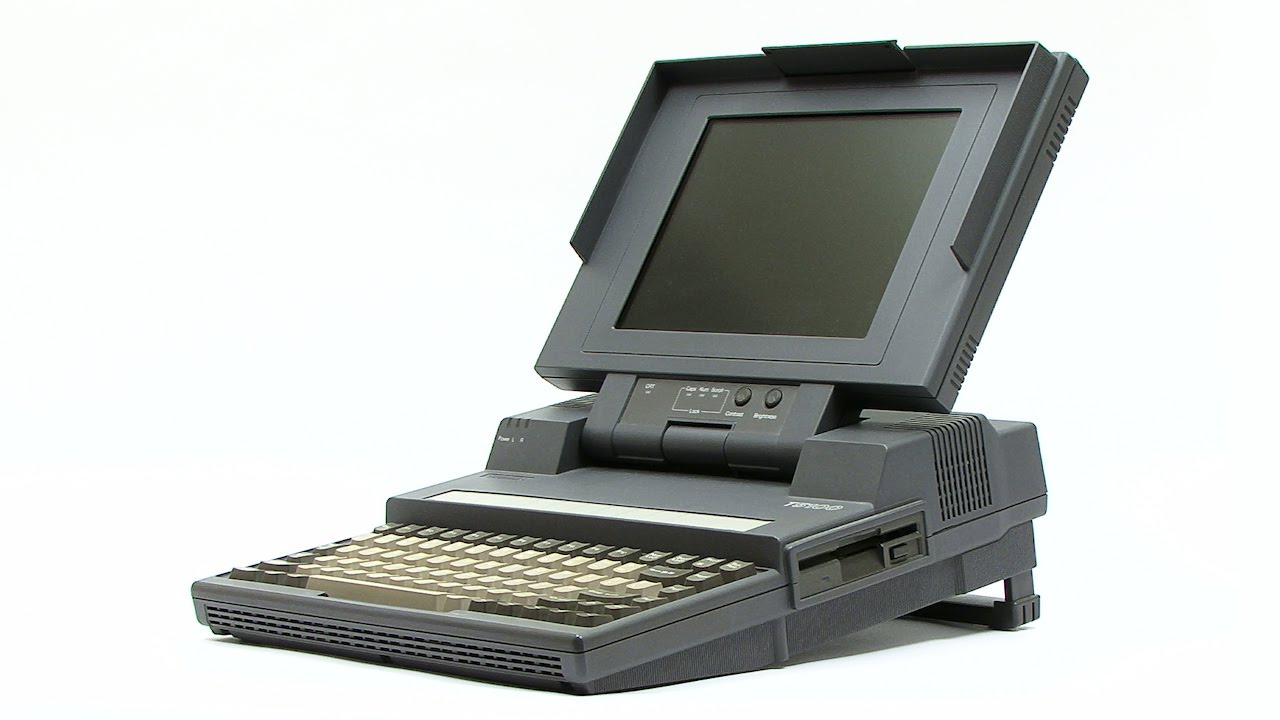
Toshiba's High End 1988 Models, the T3200 (left) and T5100 (right)
NEC introduced the Multispeed HD, an improved version of its earlier twin-floppy Multispeed. This one came with a 20 MB hard disk and a brand new backlit LCD display that was almost as good as the class-leading Zenith Z-183 at the time. The Multispeed HD came with a blazing NEC V30 CPU running at 9.54 MHz. List price was $3,695. Battery life with moderate disk access was 1 hour 55 minutes.
Motherboards
Back in 1988 you could purchase motherboards separately, but this would have been to replace a pre-existing one, as the concept of home-built PCs wasn't yet a thing. An 80286 12 MHz, zero wait-state motherboard with 8 expansion slots and an Award BIOS would sell for around $399 with no memory (and of course no CPU).
Printers
Your choice of printers was still quite a simple affair: either dot matrix or laser, though dot matrix colour printers were now available. The big players in dot matrix printers were Epson (of course), NEC, Okidata, and Citizen, though other companies like Diconix (part of Kodak), IBM, Panasonic and Toshiba were also there with their offerings.
Oki's Okimate 20 was about the cheapest dot matrix printer on the market, at just $122. Citizen's extremely popular 120D (120 cps, characters per second) was also cost-effective at $150. An Epson LX-800 80-column printer which offered 150cps was $180. Star Micronics' NX-1000, which was slightly slower at 140cps was the same price.
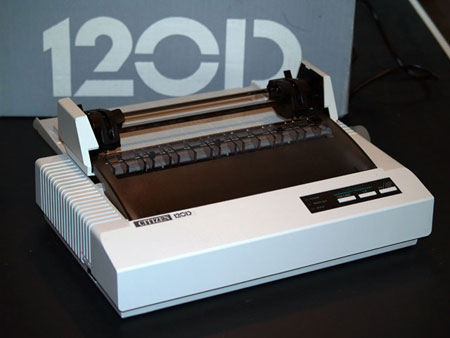
Laser printers were still pricey - an HP Laserjet II cost $1,700 - but this was also the year the first inkjet printers arrived. HP introduced the Deskjet for just $689, claiming laser quality printing for a fraction of the price.
Monitors and Graphics Cards
In 1988 monochrome monitors started at around the $90 price point for a 12" amber or green screen one - this would be a good brand like Philips or Samsung.
CGA colour monitors (often just referred to as "RGB Colour") started at $240. EGA was the midpoint at $390, while a Compaq colour VGA monitor was $550. If you had no limits you would push to an NEC Multisync XL 19" colour VGA, though it would cost you just under $2,000. If that was too much a 14" NEC Multisync II was a more palatable $600.
VGA cards from Orchid, Paradise, Genoa and Video 7 started at about $280. If you were looking for a decent EGA card, ATI EGA Wonder cost $200, while their Super-EGA Hi-Res 800x600 one was $240. At the cheapest end of the EGA bin was the Paradise auto-switching EGA 480 for $170.
Hard Disks
In 1988, hard cards were popular. a MiniScribe 30 MB "Flashcard" was yours for $425.
Basic MFM/RLL hard disks were now up to 80 MB in capacity, but for large businesses you could get an ESDI hard disk up to 380 MB.
A 40 MB MiniScribe MFM hard disk with 28ms access time sold for around $610. For 80 MB this was $850. Seagate tended to be cheaper, with an ST-225 20 MB drive going for around $270, an ST-238 30 MB for $320, 40 MB for $590 and 80 MB for $740.
Other Hardware
A 360 KB 5.25" floppy disk drive would cost about $110.
A Logitech C7 bus mouse cost $90 and a Microsoft serial mouse cost $130.
They usually came bundled with some form of paint software like Dr. Halo.
A 150W XT power supply cost $70.
A 101-key Enhanced keyboard was $105.
Math coprocessors were still in widespread use of course, with an 8087-2 costing $160, an 80287-10 $340 and an 80387-20 a whopping $770!
Modems were still super slow, coming in either 1200 baud or 2400 baud speeds, with the former selling for about $75 and the latter, $180. 1988 would see the very first 9600 baud modems hit the market from key players Hayes with their V-series Smartmodem 9600, USRobotics with the Courier HST, and more from Racal-Vadic, Concord and others. Prices of these at launch were through the roof, averaging between $895 and $2,000.
AST's SixPak Plus 576 board was going for $150, and for those looking to expand their XT to 286 performance, the Hot Shot 286 Accelerator could be yours for $350. If you already had a 286 and wanted 386 power, the Intel Inboard 386 cost $799.
A pack of 10 Maxell 5.25" DS/DD (360 KB formatted) floppy disks cost about $9.50, or for the newer 3.5" DS/DD (720 KB formatted) floppies, these were $18.50. Oddly, Sony branded diskettes were slightly cheaper at $7.99 for 10 of the 5.25" variety, and $16.99 for the 3.5" ones.
Software
The operating system of choice was still MS-DOS 3.3, though version 4.0 would be released in August of this year, offering hard disk capacities up to 2 GB. The larger utilities now supported the use of a mouse, and disks now got a unique serial number when they were formatted. MS-DOS 4.0 was buggy, so 4.01 and 4.01a soon followed.
Ashton-Tate's very popular dBase III+ sold for $389. Borland Paradox 2.0 competed against it
The popular spreadsheet, Borland Quattro was $129, which was a load cheaper than Lotus 1-2-3 at $299.
In word processing, WordPerfect was still top of the pile with version 4.2, at $199.
Central Point's PC Tools Deluxe, which offered fast hard disk backup, data recovery and disk management sold for $70.
UK DESKTOP PC Prices
Cheapest/Clearance PCs
| Olivetti PC1 | NEC V40 @ 8 MHz, 512 KB RAM | £399 |
Standard PCs
Premium PCs
US DESKTOP PC Prices
Cheapest/Clearance PCs
| CompuAdd Standard Turbo/8 | 4.77 MHz/8 MHz processing speed, 8 expansion slots, 8088 processor, 360 KB floppy diskette drive with controller, 256 KB RAM, 5060, 5151 or 101-key enhanced keyboard (your choice) | $399 |
| Noname branded XT | 8088 10 MHz, 640 KB RAM, ERSO BIOS, 150W power supply, one 360 KB floppy drive, floppy disk controller, AT type keyboard (84 keys). 20 MB hard disk and controller card version for $769. For amber 12" monitor/graphics card, add $165. For EGA card and 14" color monitor add $575. | $429 |
| Noname branded XT | 8088-1 CPU running at 4.77 or 12 MHz switchable, 0 wait states, Phoenix BIOS, 640 KB RAM, 8 expansion slots, 1 x 360 KB floppy drive, AT-type keyboard, Multi I/O (ser/par/Clock/calendar with battery backup) with floppy controller, 150W PSU. Base system only (no monitor). Add $120 for Samsung 12" mono amber monitor and mono graphics card, $290 for Samsung 14" RGB color monitor and CGA card, or $440 for Samsung 14" EGA color monitor and EGA card 640x350. | $485 |
| Packard-Bell PB88 | Turbo XT, 512 KB RAM, single floppy drive, mono graphics and monitor, keyboard. 20 MB hard disk version = $956. | $645 |
| CompuAdd Career Starter Kit | Standard Turbo/10 computer, 640 KB RAM, 150W PSU, half-height 360 KB floppy drive, 5060-style keyboard and system reset button, monographics video (high-resolution 750x350) amber monochrome monitor with 12" screen, monochrome graphics card and printer port. Star Micronics NX-1000 printer, Professional Zen software MS-DOS and GW-BASIC, 200 sheets continuous form paper, printer cable, and 10 double-sided double density blank diskettes. EGA version with 14" color monitor for $1,195. | $795 |
| Dell System 100 | With bundled software worth over $400 (MS-DOS, DOS Manager and Microsoft Works), the System 100 was cost-effective for a good brand PC. Intel 8088 running at 9.54 MHz, 640 KB RAM, 3.5" 720 KB floppy drive, 84-key keyboard, 1 serial, 1 parallel, mono graphics card and monitor. $799. Add a second floppy = $949, 20 MB hard disk = $1,299. To move to colour CGA, a single floppy version was $899, 2 floppies $1,049 or 20 MB hard disk = $1,399. VGA mono and single floppy = $999, twin floppy = $1,149, 20 MB HDD = $1,499. VGA Colour and single floppy = $1,199, twin floppy = $1,349 and 20 MB HDD = $1,699. | $799 |
| Olivetti M24 (AT&T 6300) | 640 KB, single floppy drive. Add a 20 MB hard disk = $1,159, 30 MB = $1,187, 40 MB = $1,410. | $849 |
Standard PCs
| Noname branded 286 | 80286-10 MHz, 0 wait states. Base system only (no monitor). Add $120 for Samsung 12" mono amber monitor and mono graphics card, $290 for Samsung 14" RGB color monitor and CGA card, or $440 for Samsung 14" EGA color monitor and EGA card 640x350. | $875 |
| Noname branded 286 | 80286-12 MHz, 0 wait states, 512 KB RAM expandable to 1 MB, Phoenix BIOS, Clock/calendar with battery backup, Dual floppy/hard disk controller card, 1.2 MB floppy drive, 101 enhanced keyboard, 200W PSU. Base system only (no monitor). Add $120 for Samsung 12" mono amber monitor and mono graphics card, $290 for Samsung 14" RGB color monitor and CGA card, or $440 for Samsung 14" EGA color monitor and EGA card 640x350. | $945 |
| Noname branded 286 | 80286-16, 640 KB RAM (80ns), Onboard clock/calendar, Eden BIOS (w/ set up software), 200W power supply, one 1.2 MB floppy drive, hard & floppy controller, enhanced capacity keyboard, SI v3.0 18.7. 20 MB HD version = $1,829, 40 MB HD version = $2,039, 60 MB HD version = $2,439. For amber 12" monitor/graphics card, add $165. For EGA card and 14" color monitor add $575. | $1,549 |
| CompuAdd Standard 286/12 | 6 MHz-12 MHz selectable speed, 0 wait states, 80286 processor, 5060, 5151 or 101-key Enhanced keyboard (your choice), 1 MB RAM, Clock/calendar with battery backup, Phoenix BIOS, 200-watt power supply, 1.2MB floppy drive | $1,149 |
| Micro 1 Power 286-20 | Harris 80286-20, 512 KB RAM, no hard disk, no monitor. For 32 MB hard disk and mono graphics add $805. Add VGA for $575. | $1,250 |
| IBM PS/2 Model 30 | With twin floppy drives, prices started at $1,272. Adding a 20 MB hard disk = $1,725 | $1,272 |
| Packard-Bell VT286 | 80286-10, zero wait state, 1.2 MB floppy drive, monochrome graphics and monitor. Add a 20 MB hard disk = $1,573, 40 MB = $1,724. | $1,299 |
| Dell System 220 | Dell claimed the 220 to be the fastest 286 computer on the market - "as fast as most 386 computers at less than half the price". They might have been right! 80286-20 MHz, <1 wait state, uses page mode interleaved memory (also <1 wait state) which provides about 15% increase in performance. Other stats were: 1MB RAM, integrated hard & floppy disk interface and VGA controller, 1 x 1.44 MB floppy drive, enhanced 101-key keyboard, 12 mth on-site service. VGA mono started at $1,799. For VGA Color it was $1,999, and for "VGA Color Plus" it was $2,099. Add a 40 MB hard disk for $700 or a 100 MB hard disk for $1,600. | $1,799 |
| Zeos 286-20 | Harris 80286-20, 1 MB RAM, no hard disk, no monitor. | $1,845 |
Premium PCs
| Dataworld Data 286-20 | Harris 80286-20, 1 MB RAM (100ns), 32 MB hard disk, Hercules monochrome display. No hard disk = $1,555. Extra 1 MB RAM: $450. VGA system and 32MB hard disk = $2,743. | $1,938 |
| Noname branded 386 | 80386[DX]-16, 1 MB RAM (120ns), 64 KB RAM cache, 6 x 16-bit ISA slots, 2 x 8-bit ISA slots, 1.2 MB floppy drive, 101-key Enhanced keyboard, 195W power supply, monochrome graphics card and 14" mono monitor. Add a 40 MB hard disk = $2,420, 70 MB = $2,725, 130 MB = $3,890. For EGA graphics with 14" Evervision monitor add $320. | $1,995 |
| Gateway 2000 A12 | 80286-12, Phoenix BIOS, 1 MB zero wait-state RAM (100ns), 1 x 5.25" 1.2 MB floppy drive, 1 x 3.5" 1.44 MB floppy drive, Seagate ST251 (40 MB) hard drive, 14" Samsung EGA monitor (640 x 350), Sigma Designs Autoswitch EGA card, 101-key Enhanced keyboard, 1 parallel port, 2 serial ports, battery-backed clock/calendar, 8 expansion slots. | $1,995 |
| Compaq Deskpro 286 Model 1 | Prices start from $2,095. For a 40 MB hard disk version it's $2,580, for 70 MB it's $2,895. | $2,095 |
| AST Premium/286 | 80286-10, 1 MB RAM, 40 MB hard disk (28ms access time), 1.2 MB floppy, serial/parallel/clock card, 101-key Enhanced keyboard, MS-DOS 3.2 + BASIC, 1 year nationwide warranty | $2,195 |
| Northgate 286/20 SuperMicro | Harris 80286-20, 1 MB RAM, 65 MB hard disk, 14" flat-screen mono | $2,499 |
| Dell System 220 | Harris? 80286-20, 1 MB RAM, Conner 40 MB hard disk, VGA monochrome | $3,119 |
| IBM PS/2 Model 60 | With a 40 MB hard disk = $3,340, 70 MB = $3,399. | $3,340 |
| IBM PS/2 Model 80 | With a 40 MB hard disk = $4,497, 70 MB = $5,677. | $4,497 |
| Compaq Deskpro 386 | The 40 MB version started at $4,662. For the 20 MHz Model 60 (60 MB hard disk) it was $5,579. For the 20 MHz Model 130 (130 MB hard disk) it was $7,059. For the 20 MHz Model 300 (300 MB hard disk) it was $9,168. | $4,662 |
InfoWorld ran a full review of the eighth fastest 386 machines in the 14th Nov 1988 edition - these retailed for between $9,000 and $13,000!). The line-up which all had Intel 80386DX-25 processors, had these makes and models:
- ALR Flexcache 25386 (2 MB 60ns DRAM exp. to 16 MB, 64K of 25ns 0WS cache, Paradise 16-bit VGA card, 150MB 28ms ESDI hard disk)
- Compaq Deskpro 386/25 (1 MB 100ns DRAM, 32K 25ns cache, 110MB ESDI hard disk)
- Everex Step 386/25 (4 MB DRAM, Everex VGA card, 160MB CDC hard disk)
- Hertz 386/25 (2 MB DRAM exp. to 8 MB, 64K cache, Video7 VGA card, Micropolis 170MB 23ms ESDI hard disk)
- HIMS 386/25 (1 MB 80ns DRAM exp. to 8 MB, 64K 25ns cache, Tseng Labs VGA card, 110MB ESDI hard disk)
- IBM Model 70-A21 (2 MB 80ns DRAM exp. to 8 MB, 64K cache, onboard VGA, 120MB ESDI hard disk)
- Micro Express 386-25 (1 MB DRAM exp. to 8 MB, 64K cache, Video7 VGA card, Micropolis 170MB 28ms ESDI hard disk)
- Proteus 386/25GT (1 MB DRAM exp. to 8MB, 64K cache, 90MB 18ms ESDI hard disk)
No standardised benchmarking tools were used in this review, but the CPU index relative to the original IBM 6 MHz AT for these came in at between 6.3x and 7.2x (where the 6 MHz AT = 1.0).
Laptops
1988 was the year Compaq introduced its first ever 'laptop' (not their 'Portable' range, which were more accurately classified as 'luggables'). The SLT/286 ran a 12 MHz 80C286, and came with 640 KB of RAM expandable to 3.6 MB which was LIM-EMS compatible, and a 20 MB hard disk - a 40 MB version was available for an additional $600). It weighed a whopping 14 lbs, but was touted as being the perfect size for 'an airplane serving tray', measuring 13.5" wide by 8.5" deep. The 7.81" x 5.86" display was VGA-compatible which provided a 640 x 480 resolution with 8 shades of grey, and was of the "supertwist" LCD variety. Its base price was $5,399, but numerous optional extras were available including a 2400bps modem ($599), extra battery packs ($129 each), a desktop expansion base ($999), a laptop carrying case ($89), MS-DOS 3.31 ($120) or OS/2 version 1.0 ($325).
| Compaq Portable II | For the Model 2 prices started at $1,896. For the Model 4, this went up to $2,797. | $1,896 |
| Compaq Portable III | For the Model 20 prices started at $3,577. For the Model 40, this went up to $4,159. | $3,577 |
| Compaq Portable 386 | 80386-20 MHz, 1 MB RAM, 40 MB hard disk, gas plasma display, full IBM enhanced-style keyboard. Hard disk upgrade option to 100 MB available for a further $4,299. | $7,999 |
| Epson Equity LT | NEC V30 @ 4.77 or 10 MHz, 640 KB RAM, Two floppy drives = $1,895 (see display options below). 640 KB RAM, One floppy drive, 20 MB hard disk = $2,995 (see display options below). Display options: Add Supertwist LCD (non-backlit) for a further $300, or backlit LCD for a further $500. |
$1,895 |
| GRiD GRiDCase 1530 | 80386 @ 12.5 MHz, Magnesium case, Backlit Supertwist LCD or Gas Plasma screen, 10 - 40 MB hard disk options. | Up to $7,000 |
| HP Portable Vectra CS | 640 KB RAM, with two 1.44 MB floppy drives. One floppy drive can be replaced with a 20 MB hard disk for a further $1,100 (this model is called the Portable Vectra CS 20). | $2,495 |
| NEC Multispeed HD | ||
| Toshiba T3100 | $3,495 | |
| Zenith Z-183 |
